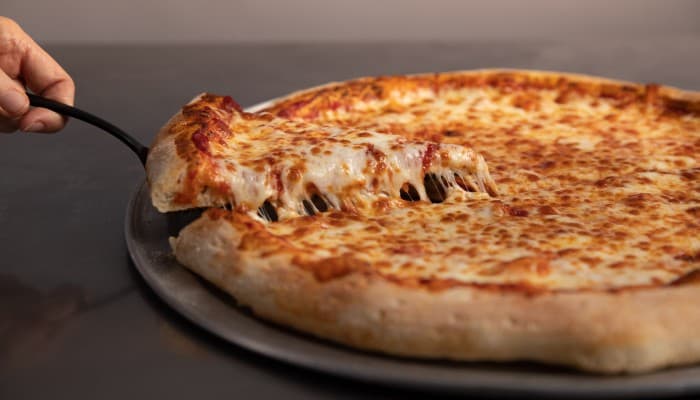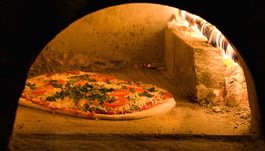
As we always say, good pizza starts with the crust. And, because there are so many fantastic pizza crust (and pizza dough) types out there, pizza makers have a ton of room to experiment. Read on for a breakdown of our favorite classic pizza styles, plus a few trendy honorable mentions.
Top Thin Crust Pizza Styles
Thin, stretched centers and crunchy edges are the typical hallmarks of thin crust pizza. Of the different styles of pizza crust, they are least capable of supporting weight and do best with less toppings. But that doesn’t limit your operation’s thin crust options—or flavor possibilities.
1| Neapolitan

According to some sources, the first pizza was made in Naples, Italy, sometime during the 1800s. This origin story gives Neapolitan pizza the reputation of being the “original” Italian pizza crust. To achieve its signature light, slightly crispy texture, traditional Neapolitan thin crust pizza must meet a very specific set of requirements.
- Dough is hand-kneaded (mechanical preparation is prohibited).
- Crust is no more than 35 centimeters (about 14 inches) in diameter, and no more than one-third of a centimeter thick (about 0.1 inches) at the center.
- Pizza is baked in a wood-fired, domed oven.
Margherita and Marinara are classic Neapolitan pizza styles, and we happen to have seriously, authentically tasty Neapolitan dough balls in our lineup.
2| New York Style Crust

New York crust vs. thin crust: what’s the difference? We get that question frequently. Answer: New York style crust is one type of thin crust.
Often sold by the slice in wide wedges, New York style pizza is among the most recognizable of thin crust pizza styles. It has been the trademark pizza of “The Big Apple” and the Northeast United States since the early 1900s, with regional variations found across the country.
New York style pizza crust is slightly crispy on the outside, yet thin and pliable so you can fold it in half for easy eating. It gets its unique flavor and texture from high-gluten bread flour and minerals present in New York City water (a not-so-secret ingredient that some out-of-state pizza makers actually import for authenticity).
You can achieve New York-style crust with frozen dough balls, too—just check out this case study.
Bonus: Brooklyn Style Crust
Brooklyn style pizza crust is similar to New York style crust, but Brooklyn tends to be crispier and enjoyed in larger slices. If you’re looking to market a Brooklyn style pizza crust to your customers, our New York Style Dough Balls will work well. It’s all in the prep when you aim to achieve New York style vs. Brooklyn.
3| St. Louis Pizza

A regional specialty in the Midwest, St. Louis pizza is characterized by its round, thin, unleavened, cracker-like crust that is sturdy enough to handle the cheddar-Swiss-provolone cheese combination this pizza is known for, plus several other toppings. Forego wedges when serving St. Louis pizza, as tradition dictates pies should be tavern cut into “party squares” or rectangles. By the way, are you a triangle or square person?
4| California Pizza

California pizza kicked off the gourmet pizza craze back in the 1970s as chefs started to experiment with non-traditional toppings. True to West Coast flair for inventiveness and originality, California pizzas bring flaky thin crusts in single-serve or traditional sizes topped with imagination—eggs, artichokes, goat cheese, smoked salmon (à la Los Angeles’s famed restaurant, Spago), avocado—the sky’s the limit.
5| Boardwalk Pizza

Image via @vitospizzawenonah on Instagram
Hailing from New Jersey, boardwalk pizzas are thin crust pies served with a sweet sauce, liberal amounts of mozzarella, and cheddar cheese. That sweet sauce is somewhat of a secret among Jersey pizzerias, but copycat sources report that adding a half teaspoon of sugar does the trick. These slices are known for on-the-go eating and considered to be best enjoyed with ocean views.
Top Thick Crust Pizza Styles
There’s no denying the heartiness of thick crust pizza. Crusts measuring at least a half-inch thick (and sometimes thicker) are prepared by hand and either rolled out or shaped to fit deep dish baking pans. They can easily handle heavy sauce and toppings, as evidenced by these tried-and-true thick crust pizza favorites.
A Note About Pan Crust vs. Thin Crust
Pan crust is under the thick crust umbrella, with a half-inch thickness. Thin crust, in contrast, is usually around a quarter-inch thick or less.
6| Detroit Style Pizza

Here’s some fun trivia: The first Detroit style pizza was allegedly made in a metal spare parts tray reminiscent of those used on automotive assembly lines. That’s a true nod to the Motor City. Another aspect of its origin is that the Detroit style pizza has some recognizable ties to the thick, rectangle-shaped Sicilian pizza that residents of Sicily, Italy, proudly created in answer to the Neapolitan thin crust.
What makes Detroit style unique among the different types of pizza crust is the medium-well done, near-fried chewy texture it has, compliments of a well-oiled pan. Add the reverse layering order (“toppings-cheese-sauce” versus the traditional “sauce-cheese-toppings”), and it’s easy to understand why Detroit style pizza has gained popularity in recent years.
If you’d like to add Detroit style pizza to your menu, check out our All-Purpose Dough Balls for Pan Pizza.
7| Chicago Style Pizza

Thick, classic deep dish from the Windy City! Chicago style pizza is characterized by a ledge that allows for a generous portion of toppings, cheese, and sauce—and by generous, we mean pizza slices up to two inches thick. The pies are baked in an oiled deep-dish pan to create a crispy, sometimes buttery, fried effect on the outside of the crust. Chicago style pizza crust commonly contains corn meal or semolina flour to give it its distinctly yellow tone and enhance its distinctive taste and texture.
8| Greek Pizza

Adopted by many in the Eastern United States, this international pie is a satisfying pan pizza that features a thick, chewy crust with a nearly deep-fried bottom. Compared to different styles of pizza crust, Greek pizza is puffier and chewier than thin crust, but not quite as thick as Chicago style. Although it’s called Greek pizza, toppings often deviate from the expected Greek salad ingredients (feta cheese, olives, and red onion). Instead, Greek pizza is regularly made with an oregano-heavy tomato paste base that complements any number of topping combinations.
9| Grandma Pizza

Grandma pizza is a throwback to simpler times. The thick crust is somewhere between Neapolitan and Chicago style, and it cradles a homespun combination of thinly sliced mozzarella cheese and canned or fresh uncooked tomatoes. Other toppings can be added, but they aren’t necessary to create an authentic Grandma pizza. This style is ideal for restaurants and other operations that have down-to-earth qualities as part of their brand.
10| Stuffed Crust

Stuffed crust pizza is the second-most popular crust style in the United States, with extra interest in Arkansas, Kentucky, Louisiana, and Mississippi. Usually, stuffed crust pizzas are on the thicker side crust-wise with a rope of mozzarella enclosed in the outer edge. The cheese-dough combo bakes up into a sort of mozzarella stick, combining two of consumers’ favorite dishes.
Of all the different types of pizza crusts and popular pies, which are best for your operation? Get up to speed on crust types, performance characteristics, and applications, plus explore sauces and dough balls in this helpful guide. Or get in touch with our team, because we can help you find cost-saving, waste-reducing ways to enhance your pizza program and get more customers in your door.
This blog was originally published on January 12, 2022, but updated and republished on February 7, 2025.




